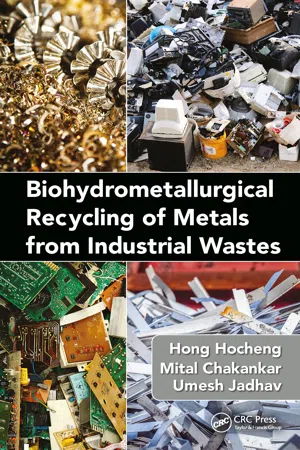
This is a test
- 212 pages
- English
- ePUB (mobile friendly)
- Available on iOS & Android
eBook - ePub
Biohydrometallurgical Recycling of Metals from Industrial Wastes
Book details
Book preview
Table of contents
Citations
About This Book
Although many available metal recycling methods are simple and fast, they are also expensive and cause environmental pollution. Biohydrometallurgical processing of metals offers an alternative to overcome these issues, as the use of biological means not only helps to conserve dwindling ore resources but also fulfills the need for the unambiguous need to extract metals in nonpolluting, low-energy, and low-cost way. This book covers biohydrometallurgy and its application in the recovery of metals from secondary sources like wastes. It aims to provide readers with a comprehensive overview of different wastes for metal recovery and biological treatment methods that are both environmentally friendly and economically viable.
Frequently asked questions
At the moment all of our mobile-responsive ePub books are available to download via the app. Most of our PDFs are also available to download and we're working on making the final remaining ones downloadable now. Learn more here.
Both plans give you full access to the library and all of Perlego’s features. The only differences are the price and subscription period: With the annual plan you’ll save around 30% compared to 12 months on the monthly plan.
We are an online textbook subscription service, where you can get access to an entire online library for less than the price of a single book per month. With over 1 million books across 1000+ topics, we’ve got you covered! Learn more here.
Look out for the read-aloud symbol on your next book to see if you can listen to it. The read-aloud tool reads text aloud for you, highlighting the text as it is being read. You can pause it, speed it up and slow it down. Learn more here.
Yes, you can access Biohydrometallurgical Recycling of Metals from Industrial Wastes by Hocheng Hong in PDF and/or ePUB format, as well as other popular books in Biological Sciences & Biotechnology. We have over one million books available in our catalogue for you to explore.
Information
1
Introduction
1.1Brief History of Industrial Progress and Generation of Industrial Wastes
Industries are the cornerstones of social and economic development. They have dynamically contributed to the growth and standard of human civilization. High-production activities in manufacturing structurally altered the economies from traditional to modern economies (Naudé and Szirmai 2012). Historically, Britain and the United States underwent a rapid industrial and economic development in the mid-eighteenth century. The industrialization which started in Britain in the eighteenth century swept through Europe and the United States and reached Japan and Russia by the end of the nineteenth century. However, by 1900, this wave had subsided (Pollard 1990). This was followed in the twentieth century by a new wave in Japan, the East Asia, and most recently China. In this industrial revolution, production technology diffused across the globe, which has fundamentally affected the nature of global production. Today, developing countries are trying to catch up through manufacturing development, while developed countries are advancing their technologies to maintain their competitiveness. However, the murky side of this technological roar is the accumulation of industrial wastes.
Industrial growth has a positive impact on humans by enhancing the quality of resources and life, but at the same time, it has a negative impact due to environmental pollution and depletion of natural resources. At first, when industrial activity was less, this impact was localized, but with the industrial progress and global expansion, this impact increased exponentially, leading to the generation of gigantic amounts of wastes; consequently, pollution is inflating at alarming rates and causing serious environmental issues globally.
Increasing population, rapid urbanization, and escalating industrialization have significantly accelerated global waste generation and thus led to unprecedented dissemination of toxic components in the environment. This is a serious global environmental issue due to its impact and stress on the environment and living beings. Moreover, continuous exploitation of natural resources has resulted in progressive depletion of nonrenewable sources (Sharholy et al. 2007, Minghua et al. 2009, Seng et al. 2011, Guerrero et al. 2013).
According to the recent World Bank report, global solid waste generation is projected to be doubled by 2025, from 3.5 million tons to 6 million tons per day, and will keep elevating so on and so forth in the foreseeable future. Furthermore, the amount of trash will be three times of today’s waste by 2100, as depicted in Figure 1.1. The global solid waste volume was about 11 billion tons per year (using 2.5 ton trucks can turn 300 circles around the equator) in 2011, and the global per capita solid waste generation was approximately 1.74 tons per year (Hoornweg et al. 2013, Song et al. 2015).

FIGURE 1.1 A scenario that assumes that current demographic and per capita waste production trends will continue (blue line) projects waste to peak sometime after 2100, as does a scenario with even greater population growth (red line). Only a scenario with a smaller, wealthier world population and more environmentally friendly consumption behaviors (gray line) enables peak garbage to occur in this century. (Reprinted...
Table of contents
- Cover
- Halftitle Page
- Title Page
- Copyright Page
- Dedication Page
- Contents
- Preface
- Authors
- Chapter 1 Introduction
- Chapter 2 Generation and Composition of Various Metal-Containing Industrial Wastes
- Chapter 3 Conventional Metal Recycling Techniques
- Chapter 4 Recycling of Electronic Waste
- Chapter 5 Recycling of Energy Storage Wastes
- Chapter 6 Recycling of Metal Production Wastes
- Chapter 7 Recycling of Solar Electricity Waste
- Chapter 8 Recycling of Thermal Power Generation Wastes
- Index